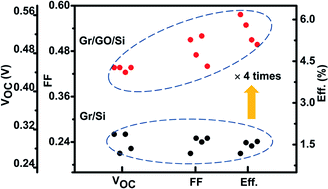Interface engineering for efficient and stable chemical-doping-free graphene-on-silicon solar cells by introducing a graphene oxide interlayer†
Abstract
Graphene-on-silicon (Gr–Si) heterojunction solar cells have recently attracted significant attention as promising candidates for low-cost photovoltaic applications. However, the power conversion efficiency of Gr–Si solar cells is generally smaller than 4% without chemical doping treatments. It is mainly limited by the low work function of Gr and high density defect states at the Gr–Si interface. Here, we have reported a new structure of Gr–Si solar cells by introducing a graphene oxide (GO) interlayer to engineer the Gr–Si interface for improving device performance. It is found that the GO interlayer can effectively increase open circuit voltage and meanwhile suppress the interface recombination of solar cells. As a result, a maximum efficiency of 6.18% can be achieved for the Gr/GO/Si solar cells, which is a new record for the pristine monolayer Gr–Si solar cell reported to date. Further, it is clarified that the Gr/GO/Si solar cell is significantly more stable than the Gr–Si solar cell with chemical doping. These results show a new route for fabricating efficient and stable chemical-doping-free Gr–Si solar cells.


 Please wait while we load your content...
Please wait while we load your content...